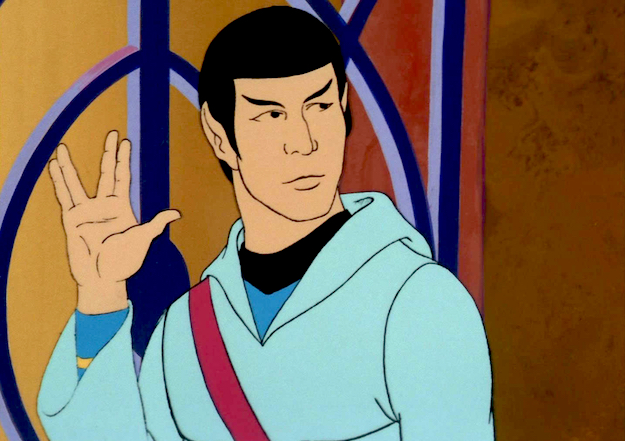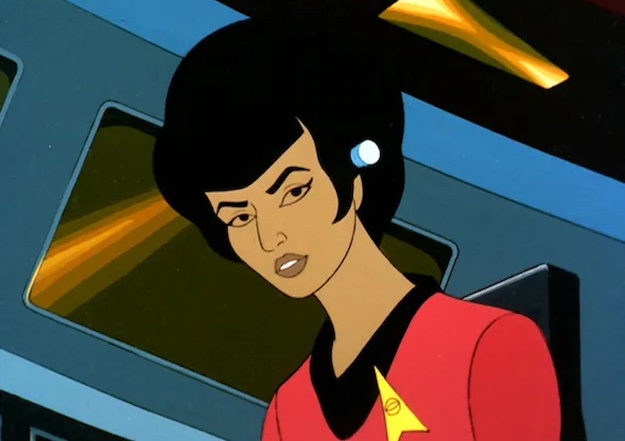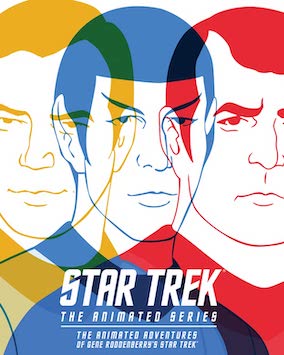
STANDOUT EPISODES
Mark A. Altman: There are a number of standout episodes in the series. Clearly, “Yesteryear,” which is a powerful story with a potent message for anyone who has ever lost a pet, is pretty extraordinary children’s television and features the last great use of the Guardian of Forever before Harlan put the kibosh on it with his many threatened lawsuits (and the less said about Discovery’s “interpretation” the better). Larry Niven’s “The Slaver Weapon” is hardcore sci-fi despite several missteps with the coloring of the Kzin. And despite the goofy premise, “The Counter-Clock Incident” is another interesting allegory about the value of older people in a youth obsessed culture.
W.R. Miller: “Beyond the Farthest Star”—The first episode that maximized Star Trek’s bounds in limited animation. “Yesteryear”—A significant glimpse of Mr. Spock’s childhood, and we finally know what a sehlat looks like. Guest starring Mark Lenard as Sarek! But why didn’t Bartell LaRue voice the Guardian of Forever? Why did James Doohan give it a spooky voice? Aleek-Om, a yellow bird creature, has a cool design. “More Troubles, More Tribbles”—Sequel to “The Trouble with Tribbles.” Stanley Adams reprises his role as Cyrano Jones, though, why wasn’t Captain Koloth voiced by William Campbell? Oddly, Scotty engages a transporter beam connecting with Jones’s ship while the Enterprise is traveling at Warp 8—512 times the speed of light! “Mudd’s Passion” – Mudd escapes his nagging wife and peddles a love potion to miners—which works! Enterprise crewmembers succumb to its influence. Lt. M’ress and Scotty find each other attractive. This, on Saturday morning television! “The Slaver Weapon”—Writer Larry Niven brings his Kzinti into the Star Trek universe. Uhura is shot—twice! “The Pirates of Orion”—A straightforward action-adventure story, which references the perpetual Spock/McCoy feud. McCoy: “Blasted Vulcan. Why couldn’t you have red blood like any normal human?” “The Practical Joker”—The Enterprise’s computer threatens the crew with practical jokes. Introducing the holodeck—that is, the rec deck. “How Sharper Than a Serpent’s Tooth”—The episode that won the series a Daytime Emmy for Outstanding Children’s Series. Also introducing an American Indian character, Ensign Walking Bear. “The Counter-Clock Incident”—Commodore Robert April saves the Enterprise crew when time reverses itself.
Jeff Bond: For me "Beyond the Farthest Star" was a great, almost movie-style intro to the series; "Yesteryear" by D.C. Fontana was a wonderfully emotional story that deepened the background of Spock so much so that it became canon for the series and has been referenced in later projects like the 2009 Star Trek movie. Probably my favorite is Larry Niven's "The Slaver Weapon." At the time I was reading Niven's Known Space series and enjoying characters like the Kzin, and seeing that brought into the Star Trek universe in a kind of crossover event was thrilling. The story also had the best kind of Star Trek writing, where we see how people of different races and cultures think differently—Spock's plan to humiliate the Kzin captain and force his hand by subjecting him to injury at the hands of an inferior "plant-eater" is sophisticated science-fiction storytelling. I also love Stephen Kandel's "Jihad," another highly sophisticated, movie-epic-scale adventure involving larger-than-life characters and action, including a zero-G fight in a temple, and a terrific and very telling story twist at the end about using religious fervor to manipulate. And only Star Trek could do a story like "The Magicks of Megas-tu" where Satan is presented as a sympathetic figure—on a Saturday morning cartoon!
Mark A. Altman: One of the other delights of the animated series are the many sequels to classic Trek episodes; the best of them being “More Tribbles, More Troubles” from the pen of David Gerrold, and “Mudd’s Passion” from Steven Kandel in which Harry Mudd is hawking a seemingly phony love potion which is almost as funny as “I, Mudd” until it turns into a Jurassic lark. Less effective, although even more surprising, is a “Shore Leave” sequel, “Once Upon A Planet.” While it’s not nearly as good as its progenitor, it’s crazy that there was actually a legitimate Trek sequel to that classic episode at all.
Daren Dochterman: All the episodes added something to the existing Star Trek canon, but I think the ones that stood out most to me were the ones that expand on previous episodes from the live action show, or did things that simply couldn’t have been done in live action. “Beyond the Farthest Star,” “Yesteryear,” “More Tribbles, More Troubles” and “Mudd’s Passion” stand out to me as shows that took the original episodes and gave reasonable sequels to them, or presented really good science-fiction ideas on a grander scale that could be conveyed in the original show. “Beyond the Farthest Star” had that creepy quality of good sci-fi and gave us a scope that wasn’t possible on the live action series.
W.R. Miller: “Yesteryear,” by D.C. Fontana.
Scott Mantz: Of course, “Yesteryear” is the very best episode. It’s the “City on the Edge of Forever” of The Animated Series. Every time I’ve seen it over the years, I’m still deeply moved and impressed that Fontana wrote this for a Saturday morning cartoon. If there was ever an episode of The Animated Series that I would have loved to have seen as a live-action episode of The Original Series, it’s this one. I mean, can you imagine? But I also love “One of Our Planets is Missing,” which bears a striking resemblance to Star Trek: The Motion Picture, which was released in theaters six years later. It’s a terrific episode that packs a lot of drama and excitement into its 24-minute running time, including the burden of command that we’ve seen Captain Kirk struggle with since the classic TOS episode “Balance of Terror.” “The Time Trap” is another fun one that would have made a great live action episode of The Original Series, and I loved seeing so many classic Star Trek aliens in one place, like the Klingons, the Romulans, an Andorian, an Orion Slave Girl and even a Gorn! Another one I love is “The Counter-Clock Incident,” which was the very last episode of TAS. Seeing the Enterprise crew age backwards made it a great companion episode to “The Deadly Years” from TOS (as well as “Rascals” from “The Next Generation”), and what better way to end the series than to have the day saved by Robert April, the first captain of the Enterprise, and the original captain first envisioned by Gene Roddenberry when he wrote his first pitch for Star Trek in March of 1964! Then there’s “The Lorelei Signal,” which did something no TOS episode ever did: It featured Uhura taking command of the Enterprise (which she did for a second time in the TAS episode “Bem”). Nichols was so elated that she reportedly said “It’s about time!” when she first read the teleplay, and you can hear that excitement in her voice. And of course, “How Sharper Than a Serpent’s Tooth,” which won Star Trek its first and only “above the line” Emmy Award. I mean, how could a Star Trek series that achieved that milestone get overlooked for all these years?
Mark A. Altman: “Yesteryear” is, by far, the series’ best episode and among the 100 best Star Trek episodes ever made, although some of my other favorites include “Mudd’s Passion,” which is a hoot (McCoy: “If the Enterprise had a heart, I’d save her too.”), and “Time Trap,” in which the Enterprise and the Klingons form an uneasy alliance to escape from the Bermuda Triangle of space. Like Bigfoot and Chariots of the Gods, the Bermuda Triangle was a big deal in the 70s.
CASTING
Jeff Bond: Clearly the actors were literally "phoning it in" although most were talented enough that their characters still shone through. I always enjoyed James Doohan's alien voices which went back to the original series and particularly enjoyed his Lt. Arex. But it did become frustrating when Doohan had to voice characters from TOS who had been portrayed by actors like William Campbell who were still around and could have been brought back to round out the voice cast.
W.R. Miller: Another example of the show’s cheap production values, not including Walter Koenig in the cast, though they did throw him a bone when they let him write an episode. James Doohan does well in voicing roles other than Scotty, but Nichelle Nichols and Majel Barrett’s voiceovers are not as convincing. Notably, the cast did an ensemble recording for the first three episodes; otherwise, they recorded separately and from different locations, as is evident on the audio quality of some of the dialogue.
Scott Mantz: At this point, we all know the story about Leonard Nimoy, who stepped up and threatened to boycott The Animated Series unless George Takei and Nichelle Nichols were invited to return as Sulu and Uhura, respectively (they were initially not included). And in the end, Takei and Nichols, along with Majel Barret and (especially!) James Doohan wound up voicing many other characters in addition to their own throughout the run of TAS. It’s a shame that Walter Koenig didn’t make the cut even after that, with Filmation saying that didn’t have enough money in the budget to include him. But how much could it have possibly cost to have him return for just a few episodes? They wouldn’t even approve to have him return as Chekov for the one episode he actually wrote, “The Infinite Vulcan”! No matter how you look at it, Koenig got a raw real.
Mark A. Altman: In the same way that fans rightly bemoan if only ILM had done the effects for Star Trek instead of Bran Ferren, it’s easy to look back and say if only they had a bigger budget to hire more guest actors instead of repeating Jimmy Doohan and Majel doing most of the guest voices. Jimmy prided himself as being a man of a thousand voices, but really he had about three. One of my biggest regrets is Doohan doing the voice of the Guardian sounding like a rejected ghost from Disney’s Haunted Mansion in “Yesteryear” instead of Bart LaRue, which is one of the few things that make it less than a perfect Star Trek episode. That and the pronunciation of Terran (as Ter-An). I love Walter [Koenig], but don’t feel it was a mistake to not include Chekov. His exclusion was a concession to the reality of budget. Obviously, the cast was pretty much phoning it in or, at least, at a disadvantage without having each other to play off of as well as get any real direction since they weren’t in the studio except for the first recording session. There’s a monotone cadence to much of the dialogue that renders some episodes less effective than others, particularly in the case of Shatner and Nimoy, as well as a fair share of mispronunciations. It’s a shame because given a broader bench of supporting and guest voice actors (like the wonderful Ted Knight as Carter Winston in “The Survivor”) and had it been recorded in the studio with the actors in the booth with a real director giving them direction, it could have elevated the series tremendously.
THE FRANCHISE
Jeff Bond: Honestly, we're in an era where literally generations are now looking back at the Trek franchise as a whole from the perspective of people who've grown up with sophisticated, expensive visual effects and sets and it takes real effort to look at programs produced in the 60s and 70s and understand the context and limitations under which they were produced. TAS was an exciting Saturday morning cartoon of the 70s that in many, many ways was more sophisticated than the rest of what was on the air at the time. On a technical level it cannot hold up to live-action programs or animation produced now (much of which is computer-assisted). But if you look at TAS purely in terms of storytelling and style (including its exciting music) I do think it holds its own and stands up to Trek of its era.
W.R. Miller: Both the original and animated Star Treks were written and/or story-edited by the same creatives and therefore compatible. The production values are self-evident.
Scott Mantz: Over the years, I used to grade The Animated Series on a curve, because of its shorter running time and the archaic animation. But looking at it now even without that curve—especially with the involvement of the original actors, veteran TOS writers and producers and the strength of the stories—I strongly believe that The Animated Series is one of the better Star Trek shows and up there with the very best of them, like The Original Series, The Next Generation, Deep Space Nine and Season Three of Star Trek: Picard.
Mark A. Altman: It's probably among the better written and more engaging of many of the series despite its many problems. I’d certainly rather watch The Animated Series any day of the week than some of the more recent live-action shows. There was a lot of intriguing sci-fi premises from noted sci-fi authors and it does capture the relationships of the original characters and feeling of classic Star Trek episodes despite the truncated running times.
THE UNINITIATED
W.R. Miller: How would I describe The Animated Series to someone who has never seen it? It depends on whether (1) they’re Star Trek fans, and (2) they’re interested in watching illustrated radio.
Daren Dochterman: It is totally TOS Star Trek. But in mutated cartoon form.
Scott Mantz: To put it simply, if you love classic Star Trek and you’ve never seen The Animated Series, you are missing out!
Jeff Bond: I would say that TAS was a show produced for children with a limited budget and resources, but that it managed to transcend a lot of those limitations to make some major contributions to Star Trek as a whole.
Mark A. Altman: Star Trek as a cartoon that plays like the lost episodes of the original series. In fact, it was one of the pioneering series with fan service. There are many nods to the original series beyond the return of beloved characters like Harry Mudd. Even Bob Wesley from “The Ultimate Computer” makes an appearance as does Cyrano Jones, the return of the Orions (incorrectly drawn though) and Walter Koenig even writes an episode. But what’s craziest of all is you even have an episode in which Captain Kirk has to defend Lucifer himself in what might be the most Star Trek-ian of conceits in “The Magicks of Megas-Tu.” Or Roddenberry-ian, at least.
THE LEGACY
W.R. Miller: Star Trek: The Animated Series was a bold experiment in bringing mature content to Saturday morning. Alas, kids preferred to watch Hanna-Barbera’s Super Friends on ABC and The Hudson Brothers Razzle Dazzle Show on CBS. And so, NBC cancelled Star Trek: The Animated Series after 22 episodes.
Jeff Bond: Again, I think TAS was the first post-TOS show to truly prove that Star Trek was a vital concept that had more life to it than a three-year network TV show. It contributed some important stories and concepts (including the holodeck which was more or less invented for the episode "The Practical Joker") and helped keep the idea of Star Trek alive through much of the 1970s.
Daren Dochterman: Still under appreciated. But a gateway drug for Star Trek.
Mark A. Altman: I think the series was largely overlooked for a long time, but has recently been rediscovered with the re-release on Blu-ray and its ubiquity on streaming along with the terrific coffee table book by Aaron and Rich which does a deep dive into the animated series. I also think the popularity of the smart and funny Lower Decks has helped shine a light on the value of the original animated series and there seems to be a lot of interest in seeing it redone with the original voice tracks and upgraded animation and scores. It seems unfeasible, but with some of the strides in artificial intelligence and the groundbreaking work Otoy is doing in recreating classic Star Trek, it’s more realistic a goal than it’s been before. And as we’ve seen before when it comes to Star Trek, nothing is impossible. I only hope that much like James Bond, one day Mr. Arex will return.
---END---

- Michael Coate
Michael Coate can be reached via e-mail through this link. (You can also follow Michael on social media at these links: Twitter and Facebook)





